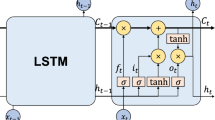Abstract
It is a widely accepted view that considering the memory effects of historical information (driving operations) is beneficial for vehicle trajectory prediction models to improve prediction accuracy. However, many commonly used models (e.g., long short-term memory, LSTM) can only implicitly simulate memory effects, but lack effective mechanisms to capture memory effects from sequence data and estimate their effective time range (ETR). This shortage makes it hard to dynamically configure the most suitable length of used historical information according to the current driving behavior, which harms the good understanding of vehicle motion. To address this problem, we propose a modified trajectory prediction model based on ordered neuron LSTM (ON-LSTM). We demonstrate the feasibility of ETR estimation based on ON-LSTM and propose an ETR estimation method. We estimate the ETR of driving fluctuations and lane change operations on the NGSIM I-80 dataset. The experiment results prove that the proposed method can well capture the memory effects during trajectory prediction. Moreover, the estimated ETR values are in agreement with our intuitions.
Similar content being viewed by others
References
Wang X, Jiang R, Li L, et al. Long memory is important: a test study on deep-learning based car-following model. Phys A-Stat Mech Its Appl, 2019, 514: 786–795
Pei X, Pan Y, Wang H, et al. Empirical evidence and stability analysis of the linear car-following model with gamma-distributed memory effect. Phys A-Stat Mech Its Appl, 2016, 449: 311–323
Sipahi R, Niculescu S I. Stability of car following with human memory effects and automatic headway compensation. Proc R Soc A, 2010, 368: 4563–4583
Treiber M, Helbing D. Memory effects in microscopic traffic models and wide scattering in flow-density data. Phys Rev E, 2003, 68: 046119
Ammoun S, Nashashibi F. Real time trajectory prediction for collision risk estimation between vehicles. In: Proceedings of IEEE 5th International Conference on Intelligent Computer Communication and Processing, 2019. 417–422
Hillenbrand J, Spieker A M, Kroschel K. A multilevel collision mitigation approach—its situation assessment, decision making, and performance tradeoffs. IEEE Trans Intell Transport Syst, 2006, 7: 528–540
Batz T, Watson K, Beyerer J. Recognition of dangerous situations within a cooperative group of vehicles. In: Proceedings of IEEE Intelligent Vehicles Symposium, 2009. 907–912
Lefévre S, Vasquez D, Laugier C. A survey on motion prediction and risk assessment for intelligent vehicles. Robomech J, 2014. doi: https://doi.org/10.1186/s40648-014-0001-z
Tay M K C, Laugier C. Modelling smooth paths using gaussian processes. In: Field and Service Robotics. Berlin: Springer, 2008. 381–390
Tran Q, Firl J. Online maneuver recognition and multimodal trajectory prediction for intersection assistance using non-parametric regression. In: Proceedings of IEEE Intelligent Vehicles Symposium Proceedings, 2014. 918–923
Aoude G, Joseph J, Roy N, et al. Mobile agent trajectory prediction using Bayesian nonparametric reachability trees. In: Proceedings of American Institute of Aeronautics and Astronautics, 2011. 1512–1529
Lee J D, Moeckli J, Brown T L, et al. Distraction Detection and Mitigation Through Driver Feedback. National Highway Traffic Safety Administration, 2013
Zheng Y, Sathyanarayana A, Hansen J. Non-Uniform Time Window Processing of In-vehicle Signals for Maneuvers Recognition and Route Recovery. SAE Technical Paper, 2015
Li G, Li S E, Liao Y, et al. Lane change maneuver recognition via vehicle state and driver operation signals-results from naturalistic driving data. In: Proceedings of IEEE Intelligent Vehicles Symposium, 2015. 865–870
Hochreiter S, Schmidhuber J. Long short-term memory. Neural Comput, 1997, 9: 1735–1780
Sak H, Senior A, Beaufays F. Long short-term memory recurrent neural network architectures for large scale acoustic modeling. In: Proceedings of the 15th Annual Conference of the International Speech Communication Association, 2014
Xing Y, Lv C, Cao D. Personalized vehicle trajectory prediction based on joint time-series modeling for connected vehicles. IEEE Trans Veh Technol, 2020, 69: 1341–1352
Altché F, de La Fortelle A. An LSTM network for highway trajectory prediction. In: Proceedings of IEEE 20th International Conference on Intelligent Transportation Systems (ITSC), 2017. 353–359
Kim B, Kang C M, Kim J, et al. Probabilistic vehicle trajectory prediction over occupancy grid map via recurrent neural network. In: Proceedings of IEEE 20th International Conference on Intelligent Transportation Systems (ITSC), 2017, 399–404
Alahi A, Goel K, Ramanathan V, et al. Social LSTM: human trajectory prediction in crowded spaces. In: Proceedings of the IEEE Conference on Computer Vision and Pattern Recognition, 2016. 961–971
Deo N, Trivedi M M. Multi-modal trajectory prediction of surrounding vehicles with maneuver based LSTMs. In: Proceedings of IEEE Intelligent Vehicles Symposium (IV), 2018. 1179–1184
Xing Y, Lv C. Dynamic state estimation for the advanced brake system of electric vehicles by using deep recurrent neural networks. IEEE Trans Ind Electron, 2019. doi: https://doi.org/10.1109/TIE.2019.2952807
Wang X, Jiang R, Li L, et al. Capturing car-following behaviors by deep learning. IEEE Trans Intell Transp Syst, 2018, 19: 910–920
Shen Y, Tan S, Sordoni A, et al. Ordered neurons: integrating tree structures into recurrent neural networks. 2018. ArXiv: 181009536
Dai S, Li L, Li Z. Modeling vehicle interactions via modified LSTM models for trajectory prediction. IEEE Access, 2019, 7: 38287–38296
Acknowledgements
This work was supported in part by National Key Research and Development Program of China (Grant No. 2018AAA0101400), National Natural Science Foundation of China (Grant No. 61790565), Science and Technology Innovation Committee of Shenzhen (Grant No. JCYJ20170818092931604), and Intel Collaborative Research Institute for Intelligent and Automated Connected Vehicles (Grant No. ICRI-IACV).
Author information
Authors and Affiliations
Corresponding author
Rights and permissions
About this article
Cite this article
Dai, S., Li, Z., Li, L. et al. Investigating the dynamic memory effect of human drivers via ON-LSTM. Sci. China Inf. Sci. 63, 190202 (2020). https://doi.org/10.1007/s11432-019-2844-3
Received:
Revised:
Accepted:
Published:
DOI: https://doi.org/10.1007/s11432-019-2844-3




